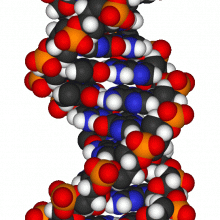The microbial world goes under the microscope this week as we hear how bacteria cause bad breath, whether probiotics can prevent allergies and eczema, and the new health threats facing Africa - diseases of affluence.
In this episode

- Where fat cells come from
Where fat cells come from
All fat is not the same, according to a report in the latest edition of the journal Cell.
Researchers at Harvard School of Public Health have discovered that a hormone produced by "home-grown" fat has big benefits for the metabolism. What's more, this is the first known example of a fat-based hormone - hormones are usually made of proteins. The hormone in question is a fatty acid known as palmitoleate.
The researchers studied mice whose fat tissue lacked two fatty acid binding proteins, and found that they were extremely healthy, resisting obesity, diabetes and other metabolic problems. But instead of finding that these animals had lower levels of fatty acids in their blood, they actually found high levels.
Further studies showed that these changes in the fat cells were having effects elsewhere in the body, including the liver and muscles, implicating that a hormone of some sort was involved. Eventually, the team discovered that the fatty acid palmitoleate was acting as a hormone. In normal mice, levels of palmitoleate drop by around half when the animal are on a high fat diet. But in the genetically engineered mice, they only have a palmitoleate drop of around 10%, which explains their resistance to the effects of a fatty diet.
The team found that palmitoleate can stimulate the effects of insulin on muscles, pushing sugar out of the bloodstream and into the muscles where it's needed, and it also prevents fat building up in the liver. It's produced when the body creates its own fat, rather than storing it from high-energy foods. So we have the unusual situation that a fatty molecule may help to prevent the buildup of fat in the body - effectively fat fighting fat.
The next step will be to see if this holds true in humans as well as mice, by measuring palmitoleate levels in healthy people and comparing them with the levels in people with metabolic problems.

Personalised medicine – developing countries show the way
Increasingly, doctors are moving towards personalised treatment for diseases including cancer and HIV infection. This means carrying out genetic tests to work out whether a person is likely to benefit from a specific treatment or not. The idea is that people are more likely to get a treatment that will work, in a timely way, as well as saving money by not giving medicines that are unlikely to be effective.
You may think that countries like the UK or US might be leading the way in personalised medicine, but judging by a special supplement published in the journal Nature Reviews Genetics this week, developing countries are actually forging ahead and leaving the west behind.
Mexico, India, Thailand and South Africa are all leading the way in personalised medicine, also known as genomic medicine, which could have important lessons for other countries in similar circumstances. The programmes of genomic medicine in these countries are aimed at improving national health, cutting medical costs, and bolstering the economy.
In Mexico, scientists have captured the genetic makeup of more than 1,200 people from different regions of the country. This is feeding into research to look at the links between genetic makeup and diseases such as high blood pressure, obesity, infections, cancer, diabetes and heart problems. Mexican experts believe that genomic medicine could cut diabetes-related healthcare costs by more than a third between 2010 and 2025.
In India, researchers found that the idea of personalised medicine stretches back more than 4,000 years, in the country's Ayurvedic tradition. Now a new genetic database contains information about 15,000 people from across the diversity of India. According to some scientists, more than 10% of Northern India's population don't respond to up to 30 important drugs. This is probably due to their genetic makeup, so understanding more about this could lead to better, more tailored treatments in the future.
Finally, in Thailand, researchers are looking for associations between genes and susceptibility to diseases such as malaria and dengue fever, while others are searching for links between genetic makeup and the likelihood of suffering post-traumatic stress disorder. While in South Africa, researchers are studying genetic diversity using samples from several indigenous tribes in Southern Africa.

Plant Sugars Provide Petrol
We all know that the days of fossil fuels are limited, so researchers are trying to find alternative fuels. Biofuels have risen in popularity in recent years - fermenting plant material to make ethanol is already being used to produce fuel in several countries around the world. But ethanol is a long way, chemically speaking, from the petrol (or gasoline for our US listeners) and diesel that are currently used in car engines.
 The problem is that plant sugars have lots of oxygen atoms in them, which aren't found in fuels like gasoline. Now scientists at the University of Wisconsin-Madison have developed a biofuel that is identical, at the molecular level, to gasoline.
The problem is that plant sugars have lots of oxygen atoms in them, which aren't found in fuels like gasoline. Now scientists at the University of Wisconsin-Madison have developed a biofuel that is identical, at the molecular level, to gasoline.
Writing in the journal Science, the researchers have found a technique for turning complex plant sugars, called lignocellulose, into molecules that can be "upgraded" to make petrol, diesel and airplane fuel. They do this by turning the plant sugars into molecules with fewer oxygen atoms, which can then be converted into high octane gasoline.
To create the new fuels, the scientists add a solid catalyst to a solution of the plant sugars. After a reaction, an oil-like substance is produced, that can be skimmed off the top of the solution. In this oil are acids, alcohols, ketones and other molecules, which are the precursors to gasoline. They can then be used in further reactions to make gasoline.
This is a much more efficient way of using lignocellulose for biofuels than previous techniques - the oil created by the team retains around 90% of the energy content found in the original sugars. Although this technique is still at an experimental stage, it might be the key to solving the oil crisis in the future.










Comments
Add a comment